engine DODGE SPRINTER 2005 1.G Repair Manual
[x] Cancel search | Manufacturer: DODGE, Model Year: 2005, Model line: SPRINTER, Model: DODGE SPRINTER 2005 1.GPages: 288, PDF Size: 27.89 MB
Page 168 of 288
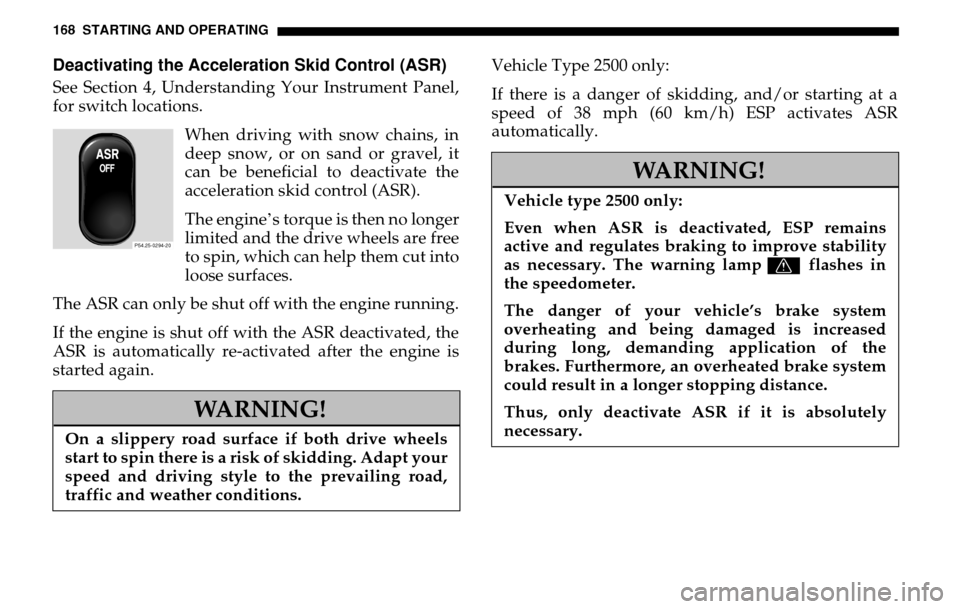
168 STARTING AND OPERATINGDeactivating the Acceleration Skid Control (ASR)See Section 4, Understanding Your Instrument Panel,
for switch locations. When driving with snow chains, in
deep snow, or on sand or gravel, it
can be beneficial to deactivate the
acceleration skid control (ASR).
The engine ’s torque is then no longer
limited and the drive wheels are free
to spin, which can help them cut into
loose surfaces.
The ASR can only be shut off with the engine running.
If the engine is shut off with the ASR deactivated, the
ASR is automatically re-activated after the engine is
started again. Vehicle Type 2500 only:
If there is a danger of skidding, and/or starting at a
speed of 38 mph (60 km/h) ESP activates ASR
automatically.
WARNING!
On a slippery road surface if both drive wheels
start to spin there is a risk of skidding. Adapt your
speed and driving style to the prevailing road,
traffic and weather conditions.
P54.25-0294-20
WARNING!
Vehicle type 2500 only:
Even when ASR is deactivated, ESP remains
active and regulates braking to improve stability
as necessary. The warning lamp
v flashes in
the speedometer.
The danger of your vehicle’s brake system
overheating and being damaged is increased
during long, demanding application of the
brakes. Furthermore, an overheated brake system
could result in a longer stopping distance.
Thus, only deactivate ASR if it is absolutely
necessary.
Page 170 of 288
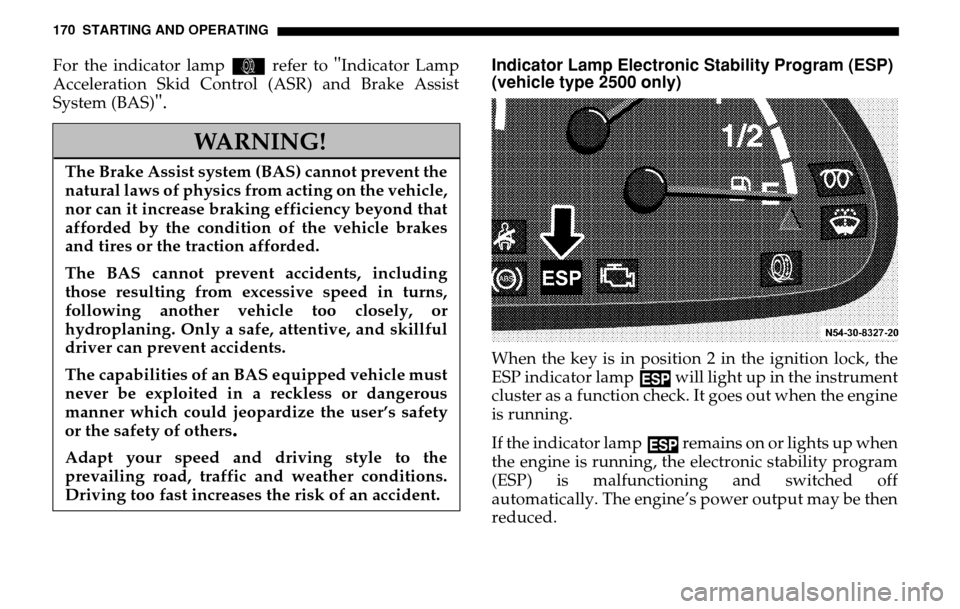
170 STARTING AND OPERATINGFor the indicator lamp k refer to
"Indicator Lamp
Acceleration Skid Control (ASR) and Brake Assist
System (BAS)
" .
Indicator Lamp Electronic Stability Program (ESP)
(vehicle type 2500 only)When the key is in position 2 in the ignition lock, the
ESP indicator lamp will light up in the instrument
cluster as a function check. It goes out when the engine
is running.
If the indicator lamp remains on or lights up when
the engine is running, the electronic stability program
(ESP) is malfunctioning and switched off
automatically. The engine’s power output may be then
reduced.
WARNING!
The Brake Assist system (BAS) cannot prevent the
natural laws of physics from acting on the vehicle,
nor can it increase braking efficiency beyond that
afforded by the condition of the vehicle brakes
and tires or the traction afforded.
The BAS cannot prevent accidents, including
those resulting from excessive speed in turns,
following another vehicle too closely, or
hydroplaning. Only a safe, attentive, and skillful
driver can prevent accidents.
The capabilities of an BAS equipped vehicle must
never be exploited in a reckless or dangerous
manner which could jeopardize the user’s safety
or the safety of others
.
Adapt your speed and driving style to the
prevailing road, traffic and weather conditions.
Driving too fast increases the risk of an accident.
Page 171 of 288

STARTING AND OPERATING 171
5
NOTE: If the ABS is malfunctioning or the voltage in
the vehicle’s electrical system drops below 10 volts, the
indicator lamp will also light up in the instrument
cluster and the ESP will be deactivated. The indicator
lamp will go out as soon as the voltage reaches this
level again or the ABS is operational again
– the ESP is
then reactivated.
Electronic Stability Program (ESP) (vehicle type
2500 only)The Electronic Stability Program (ESP) monitors the
vehicle’s traction (force of adhesive friction between
the tires and the road surface) and handling.
The ESP recognizes when a wheel is spinning or if the
vehicle starts to skid. By applying brakes to the
appropriate wheel and by limiting engine output, the
ESP works to stabilize the vehicle. The ESP is especially
useful while driving off and on wet or slippery road
surfaces.
The warning lamp v in the speedometer flashes
when the ESP is engaged, refer also to
"Warning Lamp
Acceleration Skid Control (ASR) and Electronic
Stability Program (ESP)
".
If wheels with tires of a different size than those offered
by an authorized Sprinter Dealer are used, the correct
operation of the ESP cannot be guaranteed.
WARNING!
If the ESP indicator lamp remains on, the
electronic stability program (ESP) is malfunction-
ing. The vehicle stability will no longer be auto-
matically regulated in good time.
The danger that your vehicle breaks into a skid, is
increased in certain driving situations. Drive with
extra caution.
Have the ESP repaired as soon as possible by an
authorized Spinter Dealer.
Page 172 of 288
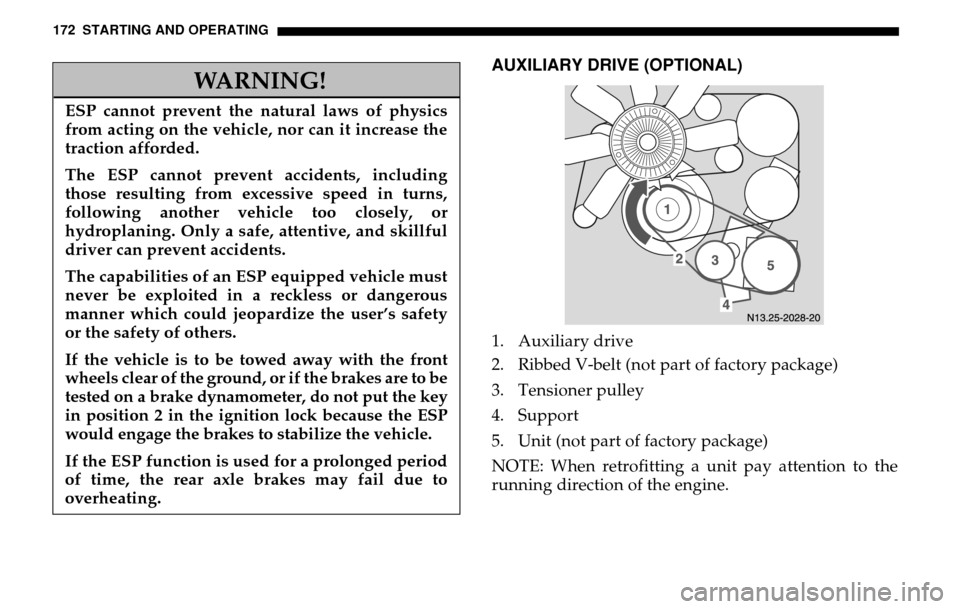
172 STARTING AND OPERATING
AUXILIARY DRIVE (OPTIONAL)1. Auxiliary drive
2. Ribbed V-belt (not part of factory package)
3. Tensioner pulley
4. Support
5. Unit (not part of factory package)
NOTE: When retrofitting a unit pay attention to the
running direction of the engine.
WARNING!
ESP cannot prevent the natural laws of physics
from acting on the vehicle, nor can it increase the
traction afforded.
The ESP cannot prevent accidents, including
those resulting from excessive speed in turns,
following another vehicle too closely, or
hydroplaning. Only a safe, attentive, and skillful
driver can prevent accidents.
The capabilities of an ESP equipped vehicle must
never be exploited in a reckless or dangerous
manner which could jeopardize the user’s safety
or the safety of others.If the vehicle is to be towed away with the front
wheels clear of the ground, or if the brakes are to be
tested on a brake dynamometer, do not put the key
in position 2 in the ignition lock because the ESP
would engage the brakes to stabilize the vehicle.If the ESP function is used for a prolonged period
of time, the rear axle brakes may fail due to
overheating.
Page 173 of 288
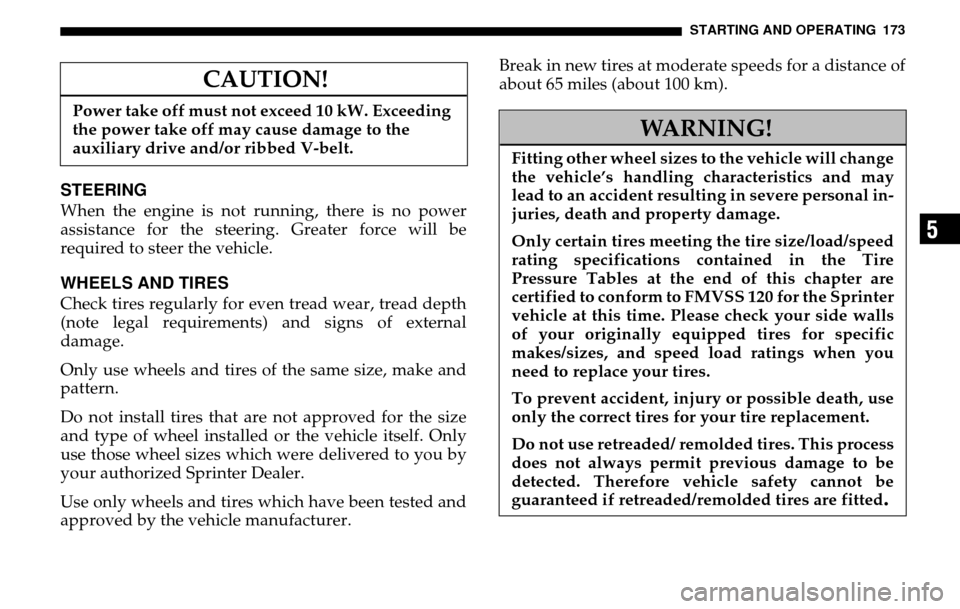
STARTING AND OPERATING 173
5
STEERINGWhen the engine is not running, there is no power
assistance for the steering. Greater force will be
required to steer the vehicle.WHEELS AND TIRESCheck tires regularly for even tread wear, tread depth
(note legal requirements) and signs of external
damage.
Only use wheels and tires of the same size, make and
pattern.
Do not install tires that are not approved for the size
and type of wheel installed or the vehicle itself. Only
use those wheel sizes which were delivered to you by
your authorized Sprinter Dealer.
Use only wheels and tires which have been tested and
approved by the vehicle manufacturer. Break in new tires at moderate speeds for a distance of
about 65 miles (about 100 km).
CAUTION!
Power take off must not exceed 10 kW. Exceeding
the power take off may cause damage to the
auxiliary drive and/or ribbed V-belt.
WARNING!
Fitting other wheel sizes to the vehicle will change
the vehicle’s handling characteristics and may
lead to an accident resulting in severe personal in-
juries, death and property damage.
Only certain tires meeting the tire size/load/speed
rating specifications contained in the Tire
Pressure Tables at the end of this chapter are
certified to conform to FMVSS 120 for the Sprinter
vehicle at this time. Please check your side walls
of your originally equipped tires for specific
makes/sizes, and speed load ratings when you
need to replace your tires.
To prevent accident, injury or possible death, use
only the correct tires for your tire replacement.
Do not use retreaded/ remolded tires. This process
does not always permit previous damage to be
detected. Therefore vehicle safety cannot be
guaranteed if retreaded/remolded tires are fitted
.
Page 179 of 288

STARTING AND OPERATING 179
5
SNOW CHAINSInstall snow chains on rear wheels only. Install snow
chains on exterior wheel in vehicles with double tires.
Comply with the manufacturer’s installation
instructions.
NOTE: Vehicles with snow chains installed are only to
be driven on a snow-covered surface. The snow chains
must be removed on road surfaces free of snow.FUEL REQUIREMENTSUse only commercially available vehicular diesel fuels
No. 2 or No. 1 (ASTM D 975 No. 2-D or No. 1-D).
NOTE: Because of its better quality the manufacturer
recommends the use of commercially available
vehicular diesel fuel No. 2.
For information on cold weather operation, contact
your authorized Sprinter Dealer. If diesel fuels are used with a sulphur content
exceeding 0.5 % by weight, engine oil change intervals
must be shortened. Please contact your Sprinter Dealer
to obtain the necessary information.
Refueling from drums or canisters may lead to the fuel
becoming contaminated. This in turn can cause faults
in the fuel system. Always f
ilter the fuel before adding
it to the vehicle’s tank.
WARNING!
Marine diesel fuel, Bio diesel fuel, heating oil or
the like must not be used.
Do not blend diesel fuel with marine diesel fuel,
Bio diesel fuel or heating oil.
The use of such non-approved fuels or blending
diesel fuel may result in malfunction or cause
engine damage. Damage or malfunctions
resulting from poor fuel quality or from blending
specific fuel additives are not covered by the
Sprinter Warranty.
Page 180 of 288

180 STARTING AND OPERATINGFuel Filter with Water SeparatorCheck the water separator when the fuel indicator
lamp does not go out or comes on while the engine
is running. For more information on the indicator
lamp .
The interval for changing the fuel filter is reduced to
10,000 miles (about 15,000 km).
Diesel Fuels for Use at Very Low TemperaturesAt very low temperatures the fluidity of No. 2 diesel
fuel may become insufficient due to parraffin
separation. For this reason the vehicle comes equipped
with a fuel preheater. It permits a troublefree engine
operation to a temperature of approximately 14 °F (–
10 °C) when using No. 2 diesel fuel.
To avoid malfunctions, No. 2 diesel fuel of a lowered
cloud point is marketed during the cold season.
A t tem pera tures below 1 4 ° F (–1 0 °C) us e win teriz ed or
No. 1 diesel fuel only. If not available, a certain
quantity of kerosene or fuel flow improver may be
added. Mixing only to be done within the vehicle’s fuel
tank. Kerosene has to be filled in before the diesel fuel.
Engine power may drop according to the proportion of
kerosene. For this reason, keep percentage of kerosene
added to the minimum necessitated by the ambient
temperature.
WARNING!
Under no circumstances should gasoline be mixed
with diesel fuel.
Due to the high pressure and high temperature in
the injection system, there is a risk of fire and
explosion.
In addition, there is a risk of engine damage.
Always follow basic safety rules when working
with any combustible material.
Page 181 of 288
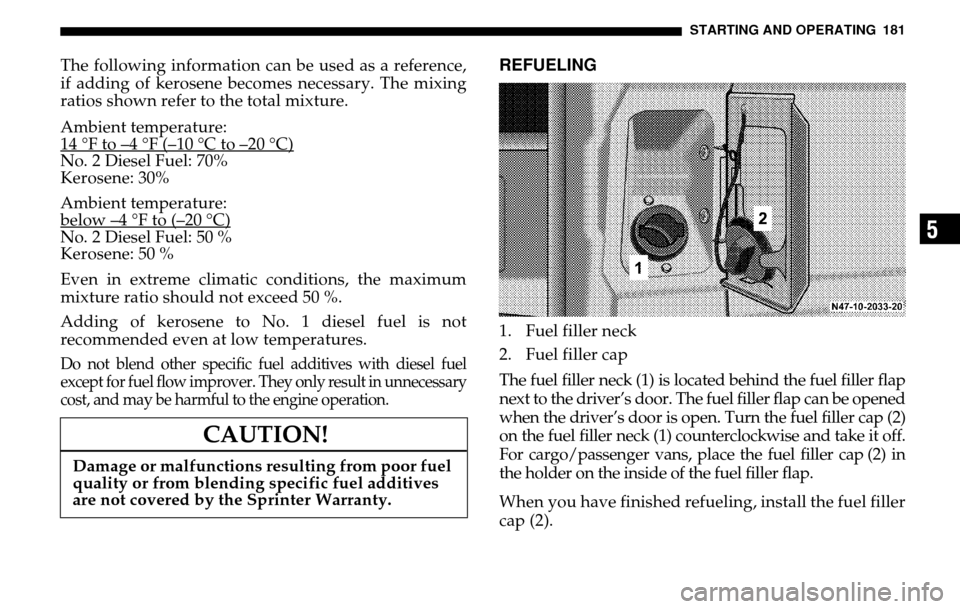
STARTING AND OPERATING 181
5
The following information can be used as a reference,
if adding of kerosene becomes necessary. The mixing
ratios shown refer to the total mixture.
Ambient temperature:
14 °F to –4 °F (–10 °C to –20 °C)No. 2 Diesel Fuel: 70%
Kerosene: 30%
Ambient temperature:
below –4 °F to (–20 °C)No. 2 Diesel Fuel: 50 %
Kerosene: 50 %
Even in extreme climatic conditions, the maximum
mixture ratio should not exceed 50 %.
Adding of kerosene to No. 1 diesel fuel is not
recommended even at low temperatures.Do not blend other specific fuel additives with diesel fuel
except for fuel flow improver. They only result in unnecessary
cost, and may be harmful to the engine operation.
REFUELING1. Fuel filler neck
2. Fuel filler capThe fuel filler neck (1) is located behind the fuel filler flap
next to the driver’s door. The fuel filler flap can be opened
when the driver’s door is open. Turn the fuel filler cap (2)
on the fuel filler neck (1) coun terclockwise and take it off.
For cargo/passenger vans, place the fuel filler cap (2) in
the holder on the inside of the fuel filler flap.When you have finished refueling, install the fuel filler
cap (2).
CAUTION!
Damage or malfunctions resulting from poor fuel
quality or from blending specific fuel additives
are not covered by the Sprinter Warranty.
Page 182 of 288

182 STARTING AND OPERATINGNOTE: Only fill the fuel tank until the fill nozzle cuts
off, do not overfill.
NOTE: Holder on the inside of the fuel filler flap only
for cargo/passenger vans.
CapacityFuel tank including reserve fuel about 26.4 US gal
(100 l).PROGRAMMED TOP SPEED (OPTIONAL)NOTE: The top speed of this vehicle can be
electronically limited to a speed between 19 mph
(30 km / h) and 82 mph (132 km / h). The vehicle’s
electronic speed controller should be programmed
only by a qualified technician by an authorized
Sprinter Dealer.
When programming the electronic speed controller,
the circumference of the specific tires actually mounted
on the vehicle must be determined and that
circumference must be correctly programmed into the
vehicle’s electronic speed controller. It is critical that
the correct tire circumference be programmed
accurately into the vehicle’s electronic speed
controller. Accurate tire circumference information
should be confirmed each time the electronic speed
controller is programmed and each time new wheels or
tires are mounted on the vehicle.
WARNING!
Always handle fuel with great care.
Shut off the engine and the auxiliary heater before
refueling.
Fuel is flammable and explosive. Keep open
flames away from the fuel.
Refrain from smoking as well as use of any
electrical equipment (such as cell phones). This
also applies to places where the characteristic
smell of fuel is evident.
If diesel fumes are noticed inside the vehicle, have
the cause traced and rectified immediately by an
authorized Sprinter Dealer.
Page 183 of 288

STARTING AND OPERATING 183
5
BLEEDING DIESEL FUEL SYSTEMIf the fuel tank was run empty, the diesel fuel system
must be bled after refueling before starting the engine.– Turn the key in the ignition lock to position 2 for at
least 30 seconds.– Return the key to position 0.– Start the engine three to four times.
The malfunction indicator light (MIL) ± must go
out.
NOTE: Too many attempts to start the engine could
drain the battery. If the engine does not start after
several attempts, consult an authorized Sprinter
Dealer.
WARNING!
Possible tire damage resulting in serious personal
injury or death may occur if the vehicle’s electron-
ic speed controller is programmed at a speed
above the maximum speed allowed by the manu-
facturer of the specific tires mounted on the vehi-
cle. The maximum speed of the tires prescribed by
the tire manufacturer must be determined and ac-
curately programmed into the electronic speed
controller. The electronic speed controller must
never be programmed at a speed greater than the
maximum allowable tire speed as prescribed by
the manufacturer of the specific tires mounted on
the vehicle.